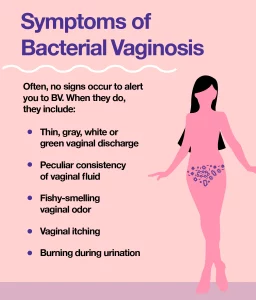What is Bacterial Vaginosis?
Bacterial Vaginosis (BV) is a common issue that happens when the balance of bacteria in your vagina gets a bit mixed up. It can make you feel uncomfortable, but the good news is that it’s not a serious problem, and it’s not something you catch from someone else.
What Causes BV?
BV happens when the “bad” bacteria in your vagina grow more than the “good” bacteria. It’s not an illness you need to worry too much about, but it can show up more if you’re sexually active.
Recognizing BV: Signs and Symptoms
Common Signs:
- Off-white or gray vaginal discharge.
- A “fishy” smell, especially after sex.
- Vaginal itching or irritation.
- A burning feeling when you pee.
Some people with BV don’t show any signs, so if you’re unsure, it’s a good idea to talk to a healthcare provider.

Understanding BV vs. Other Infections
BV vs. Yeast Infections:
- BV has a fishy smell, but yeast infections usually don’t.
- BV doesn’t usually make you itchy, but yeast infections do.
If you think something’s not right, it’s best to check with a healthcare provider.
Getting Checked for BV
If you think you might have BV, here’s what happens when you see a healthcare provider:
- Pelvic Exam: They’ll check for signs of infection.
- Vaginal Discharge Sample: They’ll take a sample to figure out what’s going on.
- Tests: There are a few tests, like the wet mount or whiff test, to help find out if it’s BV.
How is BV Treated?
BV is easy to treat with antibiotics. Your provider might give you gels, creams, or pills. It’s important to finish all the medicine, even if you start feeling better, to make sure BV doesn’t come back.
Home Treatments: Don’t use over-the-counter stuff or douches for BV. Follow your healthcare provider’s advice.
Preventing BV: Easy Tips
While you can’t totally stop BV, you can lower your chances with these steps:
- No Douching: Keep things simple and avoid douching.
- Safe Sex: Use latex condoms or dental dams during sex.
- Limit Partners: Having fewer sex partners lowers the risk.
- Breathable Underwear: Wear cotton undies to keep things dry.
What Happens if BV Comes Back?
It’s common for BV to come back, affecting a lot of people. While it’s not a big problem, if it keeps coming back, your healthcare provider might have more advice.
BV and Pregnancy
If you’re pregnant and have BV, it’s okay. Your provider can give you safe medicine. Treat BV during pregnancy, whether or not you have signs, to avoid problems.
Talking to Your Partner
Men and those assigned male at birth can’t get BV, but they can spread the bacteria. If your partner has BV, tell them so they can get the right treatment.

When to Call Your Healthcare Provider
If you notice changes in discharge, strange smells, or any discomfort, call your healthcare provider. They’re here to help. Treatment for other health problems
Common Questions Answered
- Can Men Get BV? No, but they can spread it.
- Transmission Between Individuals: Using condoms and dental dams can help lower the risk.
- BV and Pregnancy: Treat BV during pregnancy to prevent problems.
In a nutshell, BV is common, treatable, and manageable. If you ever have concerns, don’t hesitate to talk to your healthcare provider. They’re here to guide you through keeping your vaginal health in check.
Conclusion
In conclusion, Bacterial Vaginosis (BV) is a common and manageable issue that can affect the balance of bacteria in your vagina. While it might make you feel uncomfortable, especially with symptoms like unusual discharge or a “fishy” smell, the good news is that it’s easily treatable with antibiotics prescribed by a healthcare provider. Taking simple steps like practicing safe sex, avoiding douching, and wearing breathable underwear can help reduce the risk of BV.




